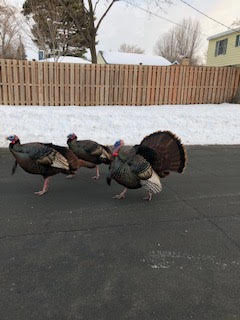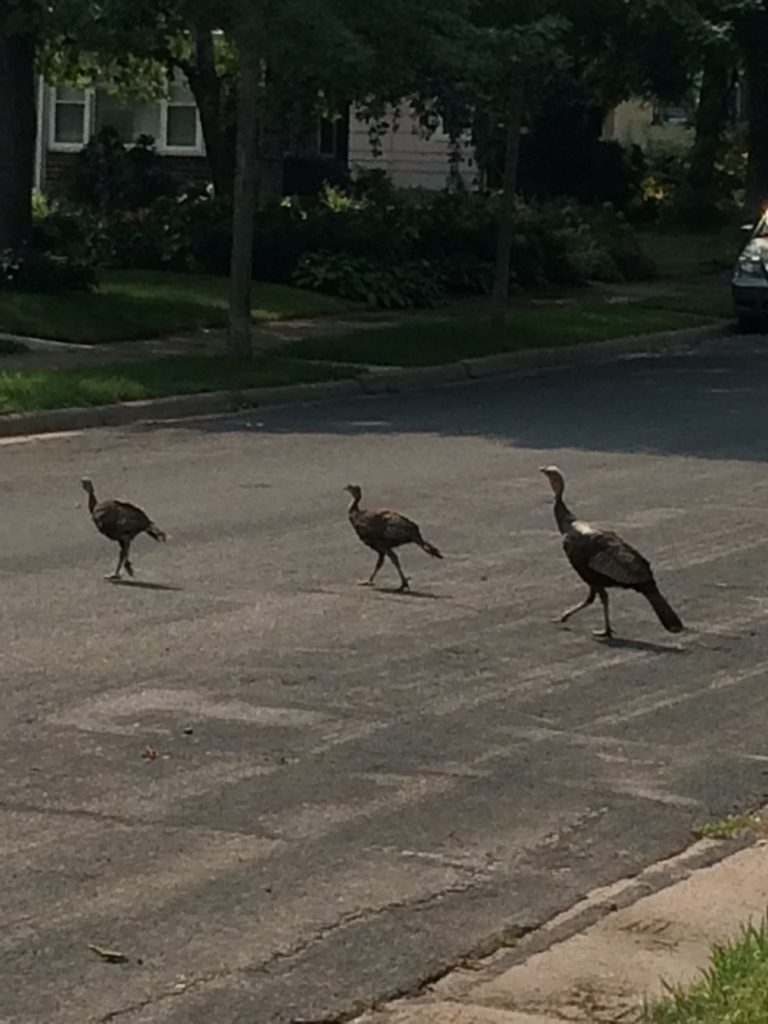
Bird of the week: November 22-28
Scientific Name: Meleagris gallopavo
Population: 7.8 million
Trend: IncreasingHabitat: Forests adjacent to open spaces, such as field, pasture, and marsh.
Gobble, Gobble
Strutting down Pleasant Avenue, a hen
and two poults hop into the cherry tree,
to snatch a snack, then flit back down,
pecking and gobbling as they go.
On our narrow, daily walks, we see them nodding
and nibbling along our neighborhood streets,
seemingly without worry.
One turkey wandered into my side-yard
garden and could not find an immediate out.
It rushed and squawked about, finally
flew over the hedge row
and escaped the garden’s confines.
I cannot say being sequestered in my garden
is a bad thing. Yet, COVID has kept us
restricted—sheltering in place, without
the freedom to roam at will. Could we rush
and scream until we escape our perceived
enclosure of mask and social distance?
This turkey trio saunters my neighborhood,
freely lurching in search of a nibble here, a nosh there—
yet where are we to stroll while we are confined?
Which is just another way of asking if we
can soldier on given current circumstances, or if
we will race for hysteria—create the drama
of escaping our self-imposed captivity.
I wondered what I would have done in that position;
wandering about, not noticing where I am, only
to find myself enclosed—well, here I am.
Yet, I am comfortable in my captivity, ordering
online, sending my spouse on errands
to chance the infected public, finding ways
to communicate instead of face to face.
With the ability to order the necessities,
get fresh air via yard space and short,
intermittent strolls as masked furtives, we are
free enough to survive this great threat.
It seems that this year’s pandemic is the current
menace, just like the Cold War gave us bomb shelters
to ready for the imminent Atomic attack.
We learned to shelter in place then, as well.
We were told to stay together in our family huddle.
Any single soul could get lost, or put
into a compromising position.
Maybe it’s better to wander in trios,
small gaggles or gangs, with
our feathers slicked back, greaser style.
Wearing a mask is optional—
if you’re a turkey.
~ Annette Gagliardi
The American Bird Conservancy reports that the Wild Turkey is the largest North American gamebird. It can weigh up to 20 pounds and have a wingspan of up to five feet. It’s colorful, too — decked out in iridescent feathers of bronze, gold, and green, accented by colorful skin ornamentation and spurred legs. Now, I’m wondering how the market sells birds that are 22-26 pounds. Hmmmm.
The wild turkey is a fast runner and strong short-distance flyer. It has excellent vision and an intelligent, wary nature that makes it elusive quarry—and I might add a ready adversary.
Fun Fact: Turkeys can run at speeds of up to 25 miles per hour and fly as fast as 55 miles per hour.

There are a trio of turkeys sauntering around our neighborhood. We have been watching them since early spring. The hen and her two poults were spotted hopping into the cherry tree in the front yard half way down the block to the south. It was fun to see them perch and strut, to peck and prance across the street, then lift and fly a short distance.
Our grandson has been practicing and can imitate many of the sounds well enough to get the poults interested in him. It isn’t just “Gobble, gobble, gobble”. Turkeys make a wide variety of other sounds, including clucks, purrs, and yelps.
At first, the birds were pretty shy. They would fast-walk away from us or turn their backs as if not looking at us would make us disappear. Luckily, we are easily distracted, not so patient as to watch for more than about fifteen minutes, so they were free to stroll about, continuing their search for food.
Wild Turkeys are omnivorous, foraging in flocks on the ground for a variety of nuts (particularly acorns), seeds, fruits, insects, and small vertebrates. They love the spilt seeds under our bird feeder and have taken a ‘dirt bath’ in the neighbor’s soft, tilled soil.
One day they were in our neighbor’s back yard, then hopped the fence to our back yard. How excited we were! The hen managed to get into our side yard, with a front exit blocked by a fence and hedge row. She got a little frantic, then flew up and over in a flash of feathers and gobble.

My daughter, who lives in Richfield said they have a whole gang of turkeys (up to fifteen) by their house, usually one or two with great plumage. The turkey gang patrols the area, rushing at dogs, people and vehicles. One day she was trapped in her car as the gobbler attacked her vehicle she was trying to park. She backed away and drove forward very carefully, so as not to run over the bird.

Turkey pecking my daughter’s car.
A UPS driver in her neighborhood was in the van, trying to distract the turkeys so he could deliver. He might have been concerned about running over one, as they had surrounded him— making driving a van seem line a dangerous line of duty. My brother, who lives in northern Minnesota says his mail carrier has been harassed by a determined turkey, as well. The bird chases the postal vehicle down the street and pecks at it each time it stops at a mailbox to deliver the post. He tried to get out several times, but was rushed and squawked at.
Who knew turkeys were so aggressive? I surely didn’t.
Fun Fact: A turkey’s gender can be determined from its droppings–males produce spiral-shaped poop and females’ poop is shaped like the letter J.
This past week after the rain, we saw the turkey trio again, this time close to Nicollet Avenue, which is a busy thorough-fare. The babies had grown, so the birds were all the same size and fairly big. Their backs which had been shades of brown/black with feather variations clearly visible, were now slicked, shiny black and intensely dense. They almost looked like different birds and a bit regal in their strutting new look. They reminded me of the young men who slicked back their hair with Brill Cream (a little dab will do ya) in the 50’s. We called them ‘greasers’, and these turkeys sure looked the part.
We worried about them being so close to the traffic of Nicollet, then realized these birds have been roaming the area all year, so were probably going to be okay. They seem to know how to stay safe in trafficked areas and we knew they were not threatened by vehicles.
I’m wondering if turkey hunting is legal within city limits. Or if a turkey meets an untimely demise in our back yard, can we skin it and cook it on the grill. My brother owns a gun and has been known to shoot deer, pheasants and a bear one time. It certainly is that time of year when turkeys should be finding places to hide.
I say, Thanksgiving cannot come too soon.

Resources:
American Bird Conservancy at: https://abcbirds.org/bird/wild-turkey/?gclid=Cj0KCQiAhs79BRD0ARIsAC6XpaXlcgt1IR3Kr1On5OthPYu7TeDsykL5JqKpGrbr8f4x_GzfaZnUQAkaAnCPEALw_wcB
“14 fun facts about turkeys” by Sarah Zielinski, November 15, 2012 for Smithsonian Magazine at: https://www.smithsonianmag.com/science-nature/14-fun-facts-about-turkeys-665520/

You’re having more fun with turkeys than we in the north woods. 🥰🥰
We pardon the National Turkey and we certainly pardon these “wild” ones! What an interesting blog! I did not know they could be so aggressive, however, I am reminded they roam in and among all the other creatures in nature. We see them on our property often west of the Twin ‘Cities. Here in Texas we see them too, however they are not as large as they are in Minnesota!!